Crowdfunding Articles, Crowdfunding Tips, News
Key Strategies for Crowdfunding Success
Based on successful crowdfunding campaigns and our experience in the industry, here are the key strategies for crowdfunding success:
Compelling Storytelling
Craft an emotional, authentic narrative that clearly explains the problem, your solution, and why it matters. Use a story to connect with backers, emphasizing the project’s impact or uniqueness. Example: Chauncy’s Chance (GoFundMe) went viral with a heartfelt story about helping a teen in need.
Engaging Visuals
Create high-quality videos, photos, and demos to showcase your project’s functionality or purpose. Keep videos concise (2-3 minutes) and include a clear call-to-action. Example: Flow Hive 2’s Indiegogo campaign used vivid demos of “honey on tap” to captivate backers.
Community Building
Engage your audience before, during, and after the campaign with regular updates and transparent communication. Build a community through social media, email lists, or forums to create loyal supporters. Example: Oculus VR’s Kickstarter success came from rallying a passionate tech community.
Social Media and Media Outreach
Leverage platforms like X.com, Instagram, and TikTok to share shareable content and expand reach. Pitch to local or niche media outlets for broader exposure. Example: BrewDog’s equity crowdfunding on Crowdcube used bold social media marketing to grow its fanbase.
Clear Goals and Rewards
Set a realistic funding goal that covers costs but isn’t overly ambitious. Offer appealing, tiered rewards (e.g., early bird discounts, exclusive perks) to incentivize pledges. Example: Exploding Kittens (Kickstarter) offered exclusive card packs, driving $8.7M in pledges.
Transparency and Trust
Clearly outline how funds will be used and provide regular progress updates to build credibility. Address risks upfront and communicate any delays or challenges. Example: Charity: Water’s campaign gained trust by detailing how donations funded clean water projects.
Pre-Launch Preparation
Build a landing page or email list before launching to gauge interest and gather early supporters. Test your concept with a small audience to refine your pitch. Example: Pebble Time’s Kickstarter hit $1M in 49 minutes due to pre-launch hype and community prep.
Timing and Momentum
Launch when your target audience is most active (e.g., avoiding major holidays). Create urgency with limited-time rewards or stretch goals to maintain momentum. Example: Pebble Time used early bird offers to drive rapid pledges.
Choose the right crowdfunding platform for your project (e.g., Kickstarter or Indiegogo for creative/products, GoFundMe for personal causes, Crowdcube for equity).




